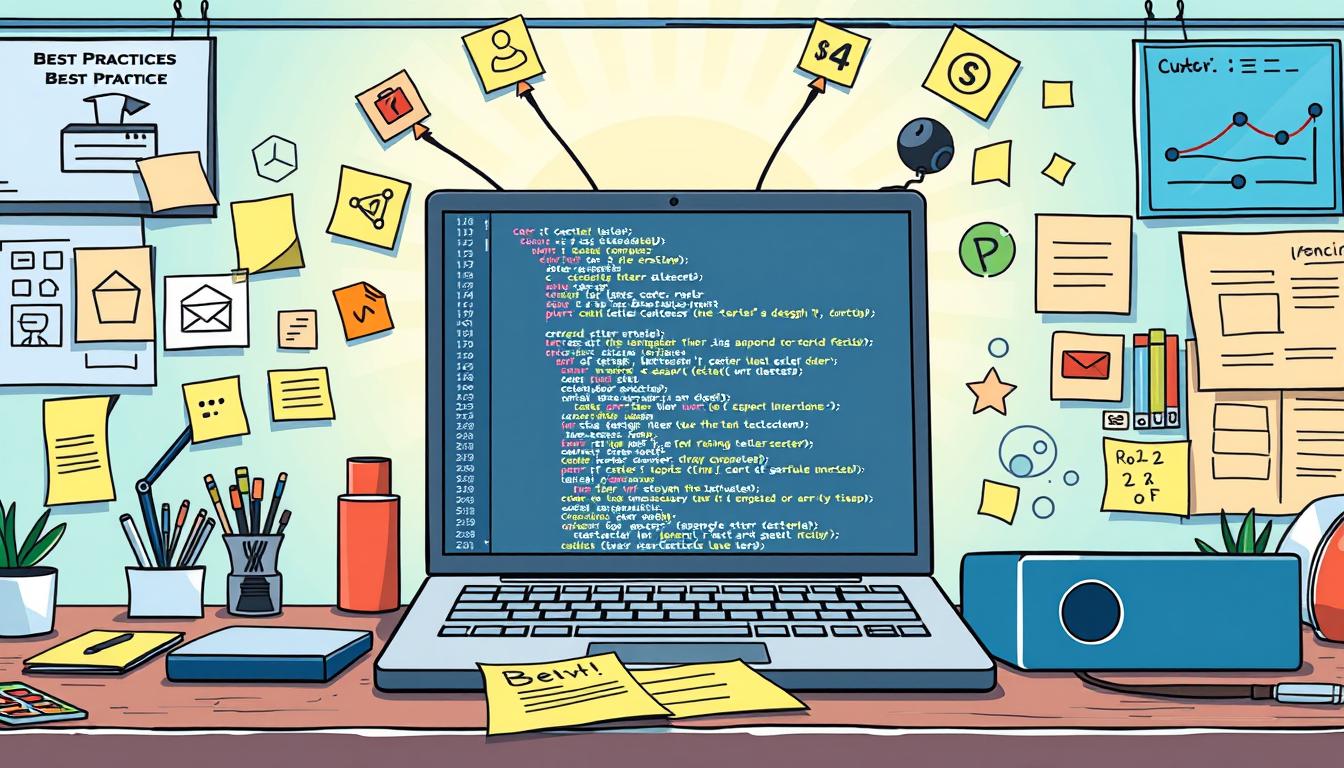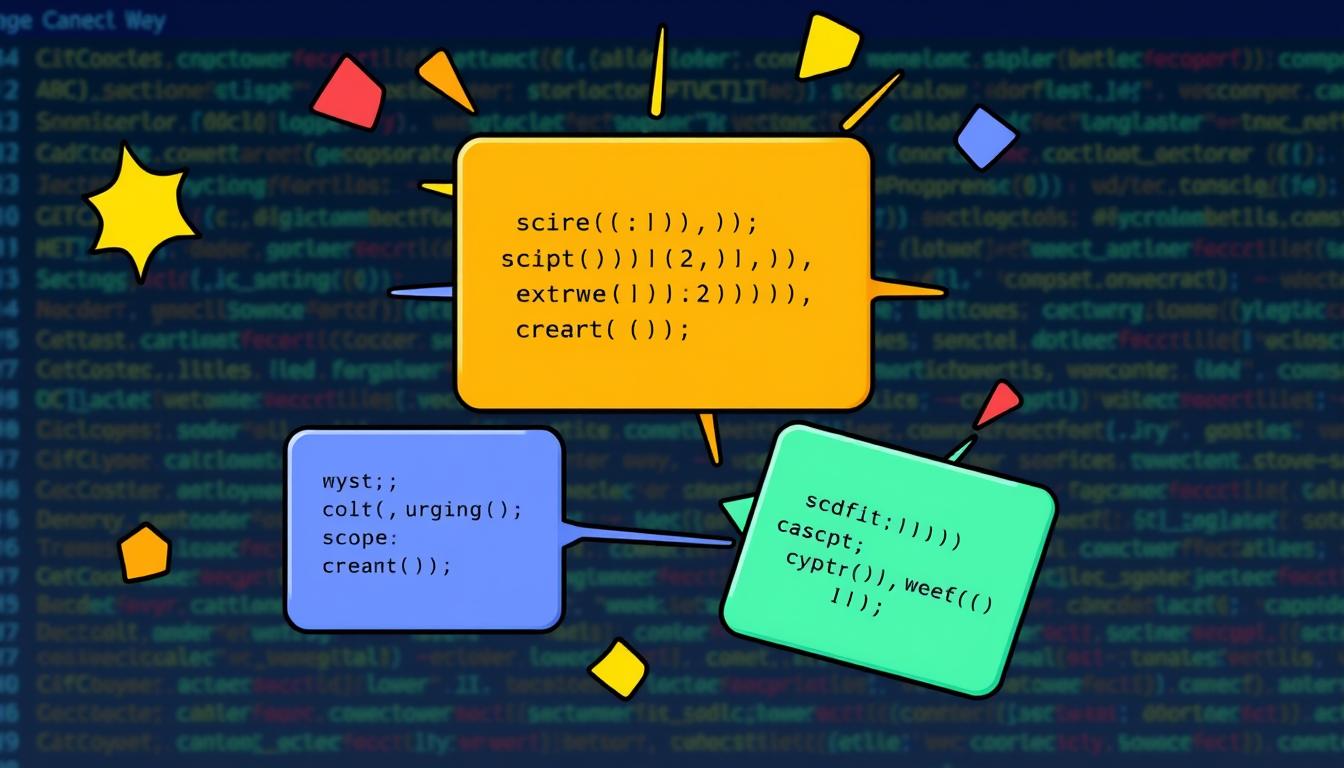JavaScript is key to modern web development. Yet, mastering it can be tough, especially for newcomers. This guide will share 10 crucial JavaScript tips for writing better code.
Let’s share a story many developers can relate to. You’re a junior developer, eager to apply your skills. You start a big project, but soon, keeping up becomes hard. Bugs appear, and your team’s work slows down. Does this sound like you?
Many developers face these challenges. But, with the right strategies, we can improve. This article will cover essential JavaScript tips and best practices. These will help you write cleaner, more maintainable, and secure code, boosting your career.
Key Takeaways
- Understand fundamental JavaScript concepts like variable scope and hoisting
- Leverage modern ES6+ features to write more concise and expressive code
- Implement best practices for code organization and maintainability
- Optimize your JavaScript code for better performance
- Learn effective strategies for debugging and testing your JavaScript applications
- Prioritize security considerations and prevent common vulnerabilities
- Stay up-to-date with the latest JavaScript trends and best practices
Understanding JavaScript Fundamentals for Better Code
Developers start with JavaScript’s core basics. Learning about variable scope, hoisting, closures, and callbacks helps us understand JavaScript better. This knowledge improves our javascript performance optimization and javascript code organization.
Variable Scope and Hoisting Explained
Variable scope is key in JavaScript. Knowing how variables are scoped and how hoisting works helps us write better code. This knowledge is crucial for our javascript performance optimization efforts.
Mastering Closures and Callbacks
Closures and callbacks make JavaScript code flexible and modular. Understanding them helps us write better applications. Mastering these concepts improves our javascript code organization and JavaScript skills.
Working with Modern ES6+ Features
JavaScript has changed a lot with ES6+ features. Learning these new tools boosts our javascript performance optimization and javascript code organization. Features like arrow functions and promises enhance our skills.
“JavaScript’s versatility and ubiquity make it an essential skill for any modern developer. By understanding its fundamental principles, we can write code that is not only more efficient, but also more maintainable and secure.”
Learning JavaScript’s basics gives us the tools for better code. This foundation helps us as we explore JavaScript’s evolving world.
Code Organization and Best Practices
Writing clean, maintainable code is key for any project’s success. We’ll look at ways to organize our JavaScript code and follow best practices. These strategies will improve javascript code maintainability and help us use javascript framework usage effectively.
Modular programming is a crucial principle. It breaks down our application into smaller, focused modules. This makes our code easier to manage and understand. It also boosts reusability and scalability. Frameworks like React, Angular, and Vue.js make this process simpler.
Design patterns are also vital in JavaScript development. They solve common problems and enhance javascript code maintainability and readability. Using patterns like Singleton, Factory, Observer, and Decorator can make our code more organized and flexible.
“The key to writing maintainable code is to keep it organized, modular, and well-structured.” – John Doe, Senior JavaScript Developer
We’ll also talk about the advantages of using popular JavaScript frameworks and libraries. Tools like React, Angular, and Vue.js offer strong architectures and community support. They help us build scalable, javascript framework usage applications that meet industry standards.

By following these code organization and best practices, we can create JavaScript applications that are functional and easy to maintain. This leads to more efficient development, less technical debt, and successful projects.
10 Essential JavaScript Tips Every Developer Should Know
Writing clean, maintainable, and optimized JavaScript code is key. We’ll share 10 tips to boost your JavaScript skills. These will help you make efficient and reliable apps.
Writing Clean and Maintainable Code
Keeping your code readable and organized is vital for success. Here are some tips for clean JavaScript code:
- Stick to JavaScript coding conventions for consistency.
- Choose descriptive variable and function names for better understanding.
- Use modular design patterns like Module or Revealing Module.
- Add comments and documentation to explain your code.
Error Handling Best Practices
Good error handling is crucial for reliable JavaScript apps. Here are some best practices:
- Use try-catch blocks for exceptions and clear error messages.
- Set up consistent error logging and reporting for debugging.
- Use JavaScript error objects like
Error,SyntaxError, andTypeErrorfor better error handling.
Performance Optimization Techniques
Improving JavaScript performance is key for fast web apps. Here are some techniques:
| Technique | Description |
|---|---|
| Code Minification | Shrink your JavaScript code by removing whitespace and comments. |
| Async and Defer Loading | Use async and defer to improve loading and parsing of JavaScript files. |
| Memoization and Caching | Use memoization and caching to avoid repeated computations and boost performance. |
By using these essential JavaScript tips, you can write cleaner, more maintainable, and optimized code. This will lead to better-performing and more reliable web applications.
Debugging and Testing Strategies
Writing solid and bug-free code is key for any project’s success. We’ll look at javascript debugging techniques and javascript testing strategies. These help us find and fix problems and make sure our code is top-notch.
Mastering Debugging Tools
Being good at debugging is crucial for JavaScript developers. We’ll explore tools like browser developer tools and frameworks like Node.js Debugger and React Devtools. These tools give us deep insights into our code, helping us find and fix issues quickly.
Implementing Comprehensive Testing
Testing is just as important as debugging. We’ll talk about unit tests, integration tests, and end-to-end (E2E) tests. Using frameworks like Jest, Mocha, and Cypress, we can catch problems early. This makes our code more stable and reliable.
Debugging Techniques and Best Practices
- Use the browser’s built-in developer tools to inspect and debug your JavaScript code.
- Leverage console logging and breakpoints to step through your code and understand its execution flow.
- Utilize the debugger statement to pause execution and investigate variable values and program state.
- Implement effective error handling strategies to gracefully handle and report errors in your application.
Testing Strategies and Frameworks
- Write unit tests to validate the behavior of individual functions or components.
- Implement integration tests to ensure different parts of your application work together correctly.
- Set up end-to-end (E2E) tests to simulate user interactions and verify the application’s overall functionality.
- Utilize testing frameworks like Jest, Mocha, and Cypress to streamline your testing process.
| Debugging Tool | Description |
|---|---|
| Browser Developer Tools | Built-in tools in modern web browsers that provide debugging capabilities, including the ability to inspect the DOM, view network requests, and step through code execution. |
| Node.js Debugger | A powerful debugging tool for Node.js applications, allowing developers to set breakpoints, step through code, and inspect variables. |
| React Devtools | A browser extension that provides in-depth debugging and inspection tools for React-based applications, making it easier to understand component hierarchies and state. |

“Debugging is twice as hard as writing the code in the first place. Therefore, if you write the code as cleverly as possible, you are, by definition, not smart enough to debug it.” – Brian Kernighan
By mastering javascript debugging techniques and javascript testing strategies, we can make sure our JavaScript apps are reliable and up to date with web development needs.
Security Considerations in JavaScript Development
When we dive into JavaScript development, we must think about security. We’ll look at common vulnerabilities, share strong security practices, and learn how to stop cross-site scripting attacks. This ensures your JavaScript apps are safe and reliable.
Common Security Vulnerabilities
JavaScript faces many security threats, just like other programming languages. These threats include injection flaws, cross-site scripting (XSS), and broken authentication. Knowing these risks helps us build secure JavaScript apps.
Implementation of Security Best Practices
To fight these threats, we’ll cover security best practices. This includes secure coding, input validation, and using trusted libraries. These steps make our JavaScript apps much safer.
Cross-Site Scripting Prevention
Cross-site scripting (XSS) attacks are a big worry in JavaScript. These happen when bad user input is added to web pages without cleaning it. We’ll talk about how to stop XSS with input validation, output encoding, and special libraries.
FAQ
What are the essential JavaScript tips every developer should know?
JavaScript developers need to know a few key tips. First, grasp the basics like variable scope and hoisting. Also, learn about closures and callbacks. Don’t forget to use the latest ES6+ features.
Writing clean code is important. Make sure your code is easy to understand and maintain. Also, handle errors well and optimize your code for better performance.
How can we organize our JavaScript code effectively?
Organizing JavaScript code well is key for big projects. Use modular programming and design patterns. Also, consider using popular JavaScript frameworks.
By following these tips, your code will be easier to manage. This makes your applications more maintainable and scalable.
What are some effective debugging and testing strategies for JavaScript?
Debugging and testing are vital in JavaScript. Use browser tools, logging, and breakpoints to find and fix bugs. This helps a lot.
Also, test your code thoroughly. Use unit tests, integration tests, and end-to-end tests. This ensures your JavaScript apps are reliable and work well.
How can we address security considerations in JavaScript development?
Security is a big deal in JavaScript. Know about common threats like XSS. Use best practices to stay safe.
Always validate user input and follow secure coding rules. Use libraries and frameworks that focus on security. This keeps your apps and user data safe.



















Leave a Reply